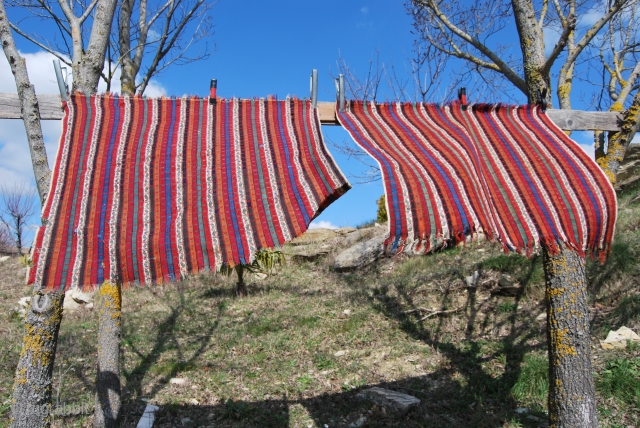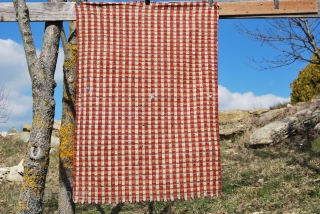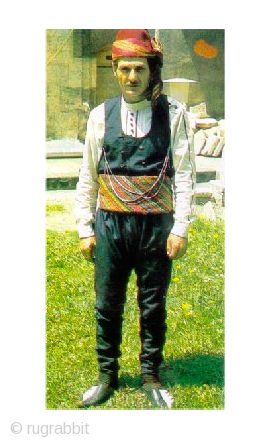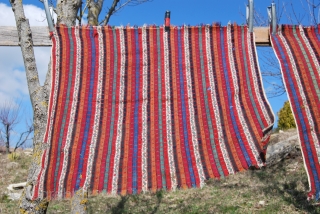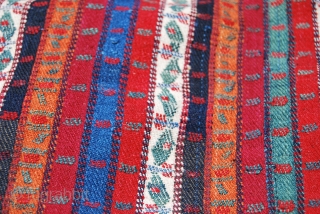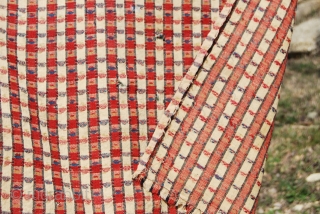Back
Three Armenian shawls/belts from Sivas. End 19th or early 20th century.Tears, holes, moth bites, but beautiful! and rare. — Armenian shawls were purchased mainly by Kurds. They were made in Gurun town, Sivas, Turkey, over 100 years ago. —— Sizes are 1 cm86x94 - 2 cm 72x102 - 3 cm 80x101
Some of the best samples of Gürün shawls can be found in the Sivas Museum and some private collections.
Shawls have been used in Turkish culture as a multipurpose clothing accessory for both males and females from ancient times. Known as “Şal” in Turkish, a shawl is a pure woolen cloth with designs that men wrap around their waist and women around their shoulders.
In the past, the most important piece of clothing of the traders were the belts made of Gürün shawls. Turkish traders used red belts, whereas Jewish and Greek traders preferred yellow belts. The shawl belts also functioned as a kind of waist bag. As such, they were used, for example, by the Janissaries to store tobacco and even pencils, in addition to many other small objects.
Residents say that the Sivas-Gürün shawls were woven until the 1920s.
The main material consist of long, shiny, and soft fibres, comes from the hair of Ankara mohair goats. The most famous shawl woven in Anatolia was the Gürün shawl.
Gürün shawls were woven on jacquard looms either with or without patterns.
The patterns formed by weaving generally consisted of vertical stripes, small flowers, and leaf-and-branch motifs placed between the stripes.
(A short extract from: Shawls of Gürün and Iran by Zahide Imer)
The Armenians of Gurun/Sivas were importing raw materials from Aleppo.
They were weaving the well known shawls on jacquard looms.The main purchasers of these shawls were Kurds who used them as belts.
If still interested see more pics on my fb page:
https://www.facebook.com/media/set/?set=a.10153296647529258.1073742022.3...
price:
pls ask
- Home
- Antique Rugs by Region
- Category
- Profiles
- Post Items Free
- Albums
- Benaki Museum of Islamic Art
- Budapest: Ottoman Carpets
- Gulbenkian Museum
- Islamic Carpets. Brooklyn
- Islamic Textiles. Brooklyn
- Konya Museum: Rugs
- MKG, Hamburg
- MMA: Caucasian Carpets
- MMA: Mamluk Carpets
- MMA: Mughal Indian Carpets
- MMA: Ottoman Carpets
- MMA: Safavid Persian Carpets
- MMA: Turkmen Rugs
- McCoy Jones Kilims
- Ottoman textiles. Met
- Philadelphia Museum
- Rugs and Carpets: Berlin
- Seljuqs at the Met
- TIEM, Istanbul: Carpets
- V&A: Classical Carpets
- Vakiflar Carpets: Istanbul
- Baluch Rugs: Indianapolis
- Gallery Exhibitions
- Jaf an Exhibition
- Alberto Levi Gallery
- Andean Textile
- Christie's London: 2016
- Francesca Galloway
- HALI at 40
- ICOC Washington, DC 2018
- Jajims of the Shahsavan
- London Islamic Week April, 2018
- Mongolian Felts
- Navajo Rugs: JB Moore
- Persian Piled Weavings
- SF Tribal & Textile Art Show 2020
- SF Tribal 2019
- Sotheby's: C. Alexander
- Turkish Prayer Rugs
- Turkmen Main Carpets ICOC 2007









